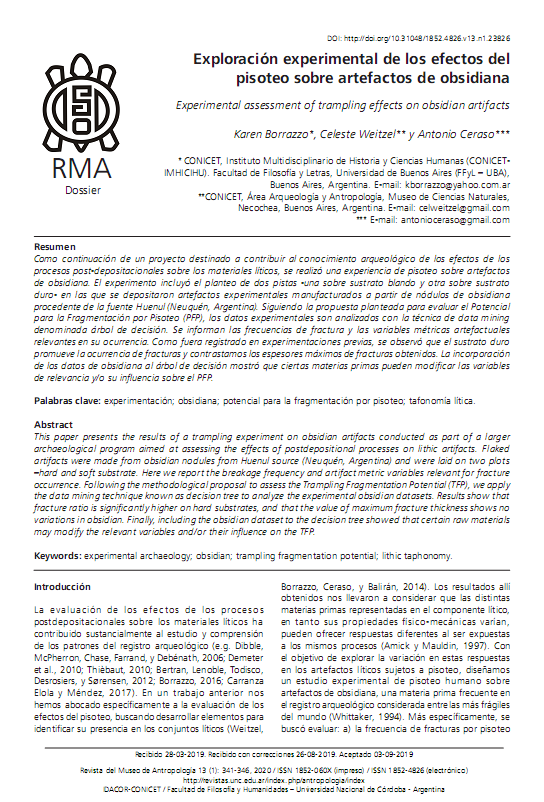Experimental assessment of trampling effects on obsidian artifacts
DOI:
https://doi.org/10.31048/1852.4826.v13.n1.23826Keywords:
experimental archaeology, obsidian, trampling fragmentation potential, lithic taphonomyAbstract
This paper presents the results of a trampling experiment on obsidian artifacts conducted as part of a larger archaeological program aimed at assessing the effects of postdepositional processes on lithic artifacts. Flaked artifacts were made from obsidian nodules from Huenul source (Neuquén, Argentina) and were laid on two plots –hard and soft substrate. Here we report the breakage frequency and artifact metric variables relevant for fracture occurrence. Following the methodological proposal to assess the Trampling Fragmentation Potential (TFP), we apply the data mining technique known as decision tree to analyze the experimental obsidian datasets. Results show that fracture ratio is significantly higher on hard substrates, and that the value of maximum fracture thickness shows no variations in obsidian. Finally, including the obsidian dataset to the decision tree showed that certain raw materials may modify the relevant variables and/or their influence on the TFP.
Downloads
References
Amick, D. S., & Mauldin, R. P. (1997). Effects of Raw Material on Flake Breakage Patterms. Lithic Technology, 22(1), 18-32.
Barberena, R., Fernández, M.V., Rughini, A.A., Borrazzo, K., Garvey, R., Lucero, G., Della Negra, C., Romero Villanueva, G., Durán, V., Cortegoso, V., Giesso, M., Klesner, C., MacDonald, B.L., & Glascock, M.D. (2018). Deconstructing a Complex Obsidian ‘Source-scape’: A Geoarchaeological and Geochemical Approach in Northwestern Patagonia. Geoarchaeology: an International Journal, 1-12. https://doi.org/10.1002/gea.21701.
Bertran, P., Lenoble, A., Todisco, D., Desrosiers, P., & Sørensen, M. (2012). Particle size distribution of lithic assemblages and taphonomy of Palaeolithic sites. Journal of Archeological Science, 39, 3148-3166.
Borrazzo, K. (2011). Tafonomía lítica en la estepa patagónica: experimentación y registro arqueológico de superficie. En L.A. Borrero & K. Borrazzo (Comps.), Bosques, Montañas y cazadores: investigaciones arqueológicas en Patagonia Meridional (p.127-153). Buenos Aires, CONICET-IMHICIHU.
Borrazzo, K. (2013). Tafonomía lítica y modelo de la dinámica eololacustre del norte de la bahía San Sebastián (Tierra del Fuego, Argentina). Revista Comechingonia, 17(1), 149-169.
Borrazzo, K. (2016). Lithic Taphonomy in desert environments: contributions from Fuego-Patagonia (Argentina). Quaternary International, 422, 18-29. https://doi.org/10.1016/j.quaint.2015.12.012.
Borrazzo, K. (2017). El rol de los criterios tecno-morfológicos en el reconocimiento de pseudoartefactos. Libro de resúmenes de las X Jornadas de Arqueología de la Patagonia, (p. 21). Puerto Madryn, CENPAT-CONICET.
Borrazzo, K.(2019). Expanding the scope of Actualistic Taphonomy in Archaeological Research. En S. Martínez, A. Rojas, y F. Cabrera (Eds.) Actualistic Taphonomy in South America, (pp 221-242). Nueva York, Topics in Geobiology 48, Springer, Cham.
Carranza Elola, J. J., & Méndez, C. (2017). Lithic Taphonomy at the Quebrada de Quereo Site: addressing the problem of anthropogenic ambiguity in Late Pleistocene Assemblages. En J. Alberti, K. Borrazzo, S. Buscaglia, A. Castro Esnal, A. Elías, & N. Franco (Eds.), 11th International Symposium on Knappable Materials “From toolstone to stone tools” (p. 199). Buenos Aires: IMHICIHU-CONICET.
Clemente Conte, I. (1997). Los instrumentos líticos de Túnel VII: una aproximación etnoarqueológica. Madrid: CSIC y UAB.
Demeter, F., Edoumba, E., Duringer, P., Bacon, A-M., Sytha, P., Bano, M., Laychour, V., Cheangleng, M., & Sari, V. (2010). Reinterpretation of an archaeological pebble culture from the Middle Mekong River valley, Cambodia. Geoarchaeology, 25(1), 75–95
Dibble, H. L., McPherron, S. J. P., Chase, P.G., Farrand, W.R., & Debénath, A. (2006). Taphonomy and the concept of Paleolithic cultures: the case of the Tayacian from Fontéchevade. PaleoAnthropology, 1-21.
Flegenheimer, N., & Weitzel, C. (2007). Caminar sobre piedras: los artefactos fracturados de Cerro El Sombrero. En XVI Congreso Nacional de Arqueología Argentina (Tomo III, pp. 263-267). Jujuy: Universidad Nacional de Jujuy.
Gifford-Gonzalez, D. P., Damrosch, D. B., Damrosch, D. R. Prior, J., & Thunen, R. (1985). The Third Dimension in Site Structure: an Experiment in Trampling and Vertical Dispersal. American Antiquity, 50(4), 803-818.
McBrearty, S., Bishop, L., Plummer, T., Dewar, R., & Conard, N. (1998). Tools underfoot: human trampling as an agent of lithic artifact edge modification. American Antiquity, 63(1), 108-122.
Nielsen, A. E. (1991). Trampling the Archaeological Record: An Experimental Study. American Antiquity, 56(3), 483-503.
R Development Core Team (2011). R: A language and environment for statistical computing, reference index version 2.2.1. URL. R Foundation for Statistical Computing, Vienna, Austria. http://www.R-project.org
Thiébaut, C. (2010). Denticulate Mousterian: myth or reality? En J. M. Burdukiewicz, & A. Wisniewski (Eds.), Middle Palaeolithic Human Activity and Palaeoecology: New Discoveries and Ideas (pp. 345-386). Wroclaw: Wydawnictwo Uniwersytetu Wrocławskiego.
Weitzel, C. (2010). El estudio de los artefactos formatizados fracturados. Contribución a la comprensión del registro arqueológico y las actividades humanas (Tesis doctoral no publicada). Facultad de Filosofía y Letras, Universidad de Buenos Aires, Argentina.
Weitzel, C., Borrazzo, K., Ceraso, A., & Balirán, C. (2014). Trampling fragmentation potential of lithic artifacts: an experimental approach. Intersecciones en Antropología, 15(Suplemento 1), 97-110.
Whittaker, J.C., 1994. Flintknapping: Making and Understanding Stone Tools. Austin: University of Texas Press.

Downloads
Published
Issue
Section
License
Those authors who have publications with this Journalaccept the following terms:
a. Authors will retain their copyrights and guarantee the journal the right of first publication of their work, which will be simultaneously subject to the Creative Commons Attribution License (Licencia de reconocimiento de Creative Commons) that allows third parties to share the work as long as its author and his first publication in this journal.
b. Authors may adopt other non-exclusive licensing agreements for the distribution of the version of the published work (eg, deposit it in an institutional electronic file or publish it in a monographic volume) provided that the initial publication in this journal is indicated.
c. Authors are allowed and recommended to disseminate their work on the Internet (eg in institutional telematic archives or on their website) before and during the submission process, which can lead to interesting exchanges and increase citations of the published work. (See The Effect of Open Access - El efecto del acceso abierto)











